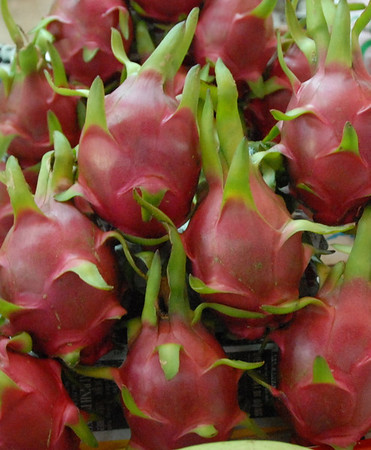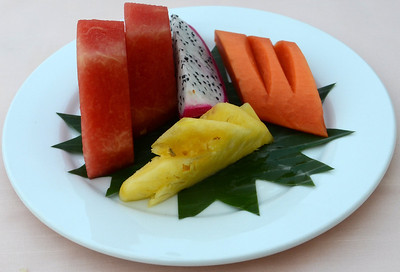
I try to live by the adage, “when in Rome . . ..” As a result, I’ve eaten a fair number of exotic and heavenly foods. I’ve also consumed more than a few odd or unpalatable things. Icelandic hakarl, or putrid shark, ranks high among these as does Vietnamese dragon fruit. Possessing hot pink skin, green spines and black-specked, white flesh, dragon fruit remains one of the flashiest edibles out there. It’s also one of the blandest that I’ve tried. Hence, seeing it touted in this week’s New York Times as the next hot food, I couldn’t help but wonder why. Granted, it’s stunning looking but . . ..
A member of the cactus family, dragon fruit thrives in tropical climates. Although native to Central America, it’s cultivated throughout South America, parts of the West Indies, Southeast Asia and Florida. In Spanish it’s called pitaya. It’s also known as the strawberry pear.
I can see the pear comparison. Similar to an unripe or winter pear, the whitish flesh is a tad gritty but juicy. Unlike a pear, this flesh is flecked with tiny, black seeds, which you can eat. That’s a relief to me for the seeds are far too numerous to consider removing.

In Vietnam I found mounds of dragon fruit in the markets. I encountered them peeled and sliced at hotel breakfast buffets. I ate them as dessert or as part of salad plates. Everywhere I went, dragon fruit was there.
Although I loved seeing this bizarre fruit, I felt apathetic about consuming it. Extremely mild in flavor, it reminded me off-season produce — it appeared gorgeous but tasted dull. As many have said before me, it was simply “refreshing.”
Don’t let my lackluster assessment dissuade you from trying dragon fruit. Look for it at your local Latin or Asian market. If you don’t want to tackle an entire fruit, you can sample it in herbal teas, fruit juice blends and energy drinks. You can also check it out in SKYY’s latest infused offering, dragon fruit.
Placed in a plastic bag and refrigerated, fresh dragon fruit will keep for up to five days. To serve, peel the fruit with a pairing knife and then cut in half or in slices. Chill before serving. The flesh can be scooped out and eaten with a spoon.